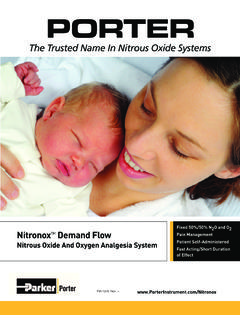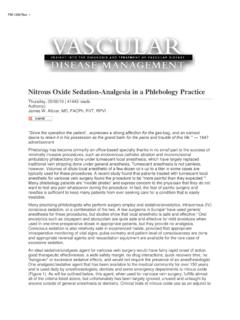Transcription of NITROUS OXIDE SENSOR USER MANUAL - Unisense
1 NITROUS OXIDE SENSOR user MANUALN itrous OXIDE SENSOR maNualCopyright 2020 Unisense A/SVersion April 2020 NITROUS OXIDE SENSOR MANUALUNISENSE A/STABLE OF CONTENTSWARRANTY AND LIABILITY ..6 CONGRATULATIONS WITH YOUR NEW PRODUCT! ..7 Support, ordering, and contact information 7 OVERVIEW ..9 GETTING STARTED ..10unpacking and connecting a new SENSOR 10pre-activation and polarization 10 Pre-activation procedure 11 Polarization 12calibration principleS 12calibration 13alternative calibration 13 Zero NITROUS OXIDE reading 13 NITROUS OXIDE response reading 13 Approval of new SENSOR 15 MEASUREMENTS ..16mounting the SenSorS 16electrical noiSe 16interference 17 ADVANCED USE OF THE N2O SENSOR ..18 STORAGE AND MAINTENANCE ..19cleaning the SENSOR 19 REFERENCES ..20 TROUBLE SHOOTING ..21 APPENDIX: EQUILIBRIUM N2O CONCENTRATIONS ..236notice to purchaSerThis product is for research use only . Not for use in human diagnostic or therapeutic procedures .warningMicrosensors have very pointed tips and must be handled with care to avoid personal injury and only by trained personnel.
2 Unisense A/S recommends users to attend instruction courses to ensure proper use of the products .warranty and liability The NITROUS OXIDE SENSOR is covered by a 60 days limited warranty .Microsensors are a consumable . Unisense will only replace dysfunctional sensors if they have been tested according with the instructions in the MANUAL within 14 days of receipt of the SENSOR (s) .The warranty does not include repair or replacement necessitated by accident, neglect, misuse, unauthorized repair, or modification of the product . In no event will Unisense A/S be liable for any direct, indirect, consequential or incidental damages, including lost profits, or for any claim by any third party, arising out of the use, the results of use, or the inability to use this product . Unisense mechanical and electronic laboratory instruments must only be used under normal laboratory conditions in a dry and clean environment . Unisense assumes no liability for damages on laboratory instruments due to unintended field use or exposure to dust, humidity or corrosive environments.
3 Repair or adjuStment Sensors and electrodes cannot be repaired . Equipment that is not covered by the warranty will, if possible, be repaired by Unisense A/S with appropriate charges paid by the customer . In case of return of equipment please contact us for return authorization . For further information please see the documents General Terms of Sale and Delivery of Unisense A/S as well as the manuals for the respective products .WARRANTY AND LIABILITY77support, orderiNg, aNd coNtact iNformatioNThe Unisense NITROUS OXIDE microsensor is a miniaturized Clark-type NITROUS OXIDE SENSOR with a guard cathode designed for research applications within environmental sciences .If you wish to order additional products or if you encounter any problems and need scientific/technical assistance, please do not hesitate to contact our sales and support team . We will respond to your inquiry within one working day .E-mail: sales@ Unisense .comUnisense A/STueager 1DK-8200 Aarhus N, DenmarkTel: +45 8944 9500 Fax: +45 8944 9549 Further documentation and support is available at our website www.
4 Unisense .com .CONGRATULATIONS WITH YOUR NEW PRODUCT!REPLACEMENT OF SENSORSU nisense will replace sensors that have been damaged during shipment provided that: The sensors were tested immediately upon receipt in accordance with the delivery note and the MANUAL The seal is still intact. The sensors are returned to Unisense for inspection within two weeks. The sensors are correctly packed for return to Unisense , in accordance with the note included in the SENSOR MANUAL covers all the Unisense N2O sensors .With its minute tip size, excellent response time, and insignificant stirring sensitivity the Unisense NITROUS OXIDE SENSOR makes it possible to make reliable and fast measurements with a high spatial resolution .The Unisense NITROUS OXIDE microsensor is a miniaturized Clark-type SENSOR with an internal reference and a guard cathode . In addition, the SENSOR is equipped with an oxygen front guard, which prevents oxygen from interfering with the NITROUS OXIDE measurements.
5 The SENSOR is connected to a high-sensitivity picoammeter and the cathode is polarized against the internal reference . Driven by the external partial pressure, NITROUS OXIDE from the environment will penetrate through the SENSOR tip membrane and be reduced at the metal cathode surface . The picoammeter converts the resulting reduction current to a signal . The internal guard cathode is also polarized and scavenges oxygen in the electrolyte, thus minimizing zero-current and polarization time .WARNINGU nisense sensors are neither intended nor approved for use on humansAVAILABLE N2O SENSORSN2O-50 (tip diameter 40-60 m)N2O-100 (tip diameter 90-110 m)N2O-500 (tip diameter 400-600 m)N2O-R (tip diameter 400-600 m - with cap)N2O-MR (tip diameter 400-600 m - in guide for microrespiration)N2O-NP (1,6 x 40 mm - needle SENSOR for piercing)10 GETTING STARTEDuNpackiNg aNd coNNectiNg a New seNsorWhen receiving a new microsensor, first remove the shock-absorbing grey plastic net.
6 Then secure the SENSOR in a safe position (e .g . micromanipulator or calibration chamber) before connecting it to the measuring meter . The signal from the NITROUS OXIDE SENSOR is generated in picoamperes . Therefore the NITROUS OXIDE SENSOR must be connected to a picoammeter amplifier unit during measurements . pre-activatioN aNd polarizatioNPlease see procedure below .Pre-activation: NITROUS OXIDE sensors have a metal cathode which during normal exposure to oxygen over time will acquire an oxidized surface layer . If the SENSOR is new or has not been used recently, this layer must be pre-activated in order for the SENSOR to work . This is done by applying a voltage of -1 .3 V for 10-15 minutes prior to the period of polarization which is required for most electrochemical sensors . Polarization: The electrolyte inside the SENSOR can contain large amounts of oxygen which must always be removed before the SENSOR is stable . This is done by the guard cathode inside the SENSOR during the period of polarization (for some other SENSOR types referred to as pre-polarization) and this process requires some time, depending on the dimensions and exact proportions of the individual SENSOR .
7 IMPORTANT:If the SENSOR is new or not recently used, follow the procedure for PRE-ACTIVATION. For recently used N2O sensors, follow the procedure for POLARIZATION. Please read both sections before starting the relevant procedure. WARNINGDo not remove the seal and protective plastic tube before these steps and calibration are successfully polarization may destroy the directions on adjusting the polarization, please consult the relevant instrument MANUAL . pre-activation procedure1 . Secure the NITROUS OXIDE SENSOR with its tip immersed in NITROUS OXIDE free water . (It does not harm the SENSOR to be in air instead, but pre-activation, polarization, and calibration might as well be made with the same set-up) . 2 . Using an fx-6, fx-3 pA, x-5 and N2O UniAmp Change the polarization to -1 .3 V in the Calibration tab of SensorTrace Suite or by using the Unisense Service in the Windows Notification Area on the PC . Using a Microsensor Multimeter or Monometer: Connect the SENSOR to the amplifier.
8 Turn the polarization to -1 .3V and leave for approximately 30 minutes . Using a PA2000 amplifier: Connect ONLY the BNC connection of the SENSOR and turn the polarization voltage to -1 .3 V . Leave the polarization at -1 .3 V for approx 10-15 min . You will see a very high signal in the beginning but this will decrease after 5 - 10 minutes .12polarization 1 . Using a fx-6, fx-3 pA, x-5, and N2O UniAmp Change the polarization back to -0 .8 V . Using a Microsensor Multimeter or Monometer: Turn the polarization voltage to -0 .8 V . Using a PA2000 amplifier: Turn the polarization voltage to -0 .8 V . Connect the yellow guard wire to the yellow connection on the meter . 2 . You will see a sharp decrease followed by a rapid increase in the signal . After this, the signal will stabilize with an initial rapid and then a more slow decrease . Wait until the signal is below 20 mV and stable . This may take many hours, e .g . 12 hours (see below) . If the SENSOR signal does not reach this value, please go to the Troubleshooting section.
9 In general you should polarize for as long as possible before calibration and measurements to get maximum stability . Unisense recommends that you perform the pre-activation the day before measurements and then leave the SENSOR to be polarized overnight . If the signal does not stabilize or is too high or too low, see Trouble-shooting .calibratioN priNciplesCalibration must be performed after the SENSOR signal has stabilized . Standard range NITROUS OXIDE sensors respond linearly in the range of 0 to 2% or 0 - 500 M NITROUS OXIDE and signals can thus be linearly converted to partial pressure . Check and repeat calibration at appropriate intervals . Shortly after taking a SENSOR into use, the appropriate interval may be 2 hours; when the SENSOR has been used for some time, it may be 24 hours . CALIBRATION As N2O micro-sensors respond linearly to changes in N2O concentra-tions, a two-point calibration is sufficient. IMPORTANTC alibration must be performed after pre-polarization when the SENSOR signal has minimize the need for calibrations, keep the SENSOR polarized between measurements, unless the time between measurements exceeds several days.
10 The membrane permeability of NITROUS OXIDE microsensors changes with time, so a change in signal of up to 50% may occur over months .calibratioNIt is recommended to use the Unisense N2O SENSOR Calibration Kit for calibrating the N2O sensors (https://www . Unisense .com/calibration_kits/) . This kit ensures accurate and simple calibration both in the lab and in the field . The calibration kit can be shipped as normal cargo and does not require dangerous goods shipping . Therefore, it is ideal also for shipping to field work, research cruises etc . The detailed calibration procedure can be found in the Calkit-N2O MANUAL (https://www . Unisense .com/manuals/)alterNative calibratioNzero NITROUS OXIDE readingPlace/keep the SENSOR tip in NITROUS OXIDE free water and read the signal . This signal is your calibration value for zero NITROUS OXIDE conditions . The temperature in the solutions for zero calibration and for known N2O concentration must be the same . NITROUS OXIDE reSponSe readingThe NITROUS OXIDE SENSOR , in the standard version, responds linearly between 0-500 M N2O (0-2% N2O.)







